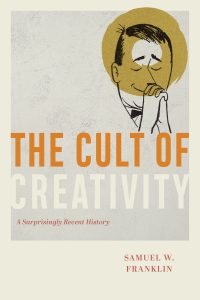What Exactly Is “Creativity”?
With his new book, The Cult of Creativity: A Surprisingly Recent History, Samuel W. Franklin uncovers how the now-ubiquitous concept of creativity was formed in the mid-twentieth century. Now one of American society’s signature values, creativity as we know it was a concept that didn’t always exist. In this post, Franklin looks at the development of creativity as an ideal—how it fits in with the needs of capitalism, where it sits in American culture, and how it brings together different qualities into one unquantifiable trait.
A prevalent narrative about cultural change in the West over the last hundred years or so is that mainstream (read: white and middle class) culture has shifted from basically Protestant bourgeoise—thrifty, moderate, obsessed with “character”—to a more romantic, self-expressive, or even hedonistic culture. Conservatives generally decry this development while liberals applaud it, and those on the left are ambivalent: Clearly the old culture had to go to make way for things like feminism and gay liberation, but how easily has personal liberation been usurped by capitalism? Not only is our self-expression achieved through lifestyle consumerism, but with personal freedom comes responsibility to make that freedom productive, to monetize it, often without the social support provided by an earlier era of corporate capitalism. When even terms like “radical” and “disruptive” become capitalist buzzwords, what even is the dominant culture against which one can rebel?
The term “creativity” sits in an awkward spot in this cultural arc. It kind of sounds like something outside of capitalism, even something naturally opposed to it or un-capturable. We associate it with rebel artists and lone-wolf thinkers, and place it opposite the “un-creative”: white button-down shirts and cubicles and rows of school desks full of students memorizing facts. We think of creative pursuits as ones we do outside of work, our passion projects, our morning pages. We chuckle at euphemisms like “creative accounting” because it transgresses the two main things we think “creative” should mean: artsy and morally pure.
Yet creativity also seems so at home in capitalism. Aren’t entrepreneurs creative? And the engineers, consultants, finance wizards, and others whose job it is to innovate and stay agile in the constantly shifting ground of the modern economy? And what about all those designers, photographers, filmmakers, and writers who populate our marketplace with the things we wear, watch, and read nearly every waking hour of our days? They are so creative we call them “creatives” and their sector the “creative industries,” and we look to them as a major engine of profit. Where is creativity at home if not in business?
Over the course of writing my bookI’ve come to realize that the term creativity, and our almost universal love for it rests on its ability to play for both teams, to keep this ambivalence open. Its ubiquity today represents our conflicted sense that the cultural changes of the last few decades are good and exciting and progressive, and that, on the other hand, they have been dehumanizing, degrading, and exclusionary.
The concept of creativity has its own narrative, which you will find in almost any book on the subject but which most of us assume to be true anyway, and which largely parallels the one about cultural liberalization. That narrative holds that creativity is a historical underdog that has only recently come into its own. Once upon a time, during the dark ages of the industrial era and the more uptight, religious, and conformist eras that preceded it, creativity was an idea discussed in hushed tones in Parisian garrets and bohemian salons and extolled by romantic poets but never seriously embraced by everyday people, and seen with great suspicion by the powers that be. But then, some time after World War II, serious people began to take creativity seriously. Psychologists began to study it, and businesses began to embrace creative people and creative methods. As we embraced creativity, the story goes, we also learned more about it: that it’s actually, contrary to popular belief, not inborn but a learnable trait, and that it’s actually, contrary to popular belief, not restricted to art but can be applied to anything. This embrace of creativity, the narrative goes, taught these institutions to appreciate things like open-mindedness, flexibility, difference, and a reflexive antagonism to the status quo, and in doing so helped to mainstream the kinds of values that one were restricted to society’s outcasts.
But what if the story of creativity is not about a long-ignored singer-songwriter who finally hits the bigtime but rather a boy band of disparate ideas—imagination, genius, originality, self-actualization, adaptability—that got thrown together under a new name and debuted as if they’d been doing it for years? For one thing, people hardly used the term at all before the twentieth century, and it wasn’t a regular word until the 1950s. Of course, that doesn’t necessarily mean the “idea” of creativity didn’t exist, but if it really was a topic going back to the romantics and the modernists why didn’t they use that term? What if creativity is like ideas that go back generations, but also meaningfully different from them? Sure, people used to think genius was rare, but we still do; did we really “discover” that creativity is a general trait, or did we repackage everyday cleverness to look more like genius? Did we really just discover that non-artists can have new ideas, or did we just start talking about inventiveness as somehow related to art?
What I’ve come to realize is that the term creativity allowed people after WWII to cluster ideas and meanings that they didn’t previously have a word to do. It was adopted, almost invented, in a sense, not to combat capitalism but rather to take what was seen as valuable about bohemian values and repackage them in a way that was also amenable to the values of capitalism. Its history therefore shows us that the supposed shift from bourgeois to bohemian values was not the victory of the latter over the former but rather a synthesis. This helps explain the cultural logic of our time, in which we read books about monks and Bob Dylan to help us write better marketing pitches and wonder why we’re so unhappy doing work that was supposed to be “creative.”

Samuel W. Franklin is a cultural historian and a postdoctoral researcher in human centered design at the Delft University of Technology. He has earned awards and fellowships from the Smithsonian Institution’s Lemelson Center for the Study of Invention and Innovation, the Hagley Library and Museum, the Hathi Trust Research Center, the Stanford Arts Institute, and Brown University’s Center for Digital Scholarship. He has developed exhibitions for the American Museum of Natural History, the National September 11 Memorial and Museum, and others. www.cultofcreativity.com
The Cult of Creativity is available now from our website or your favorite bookseller.
